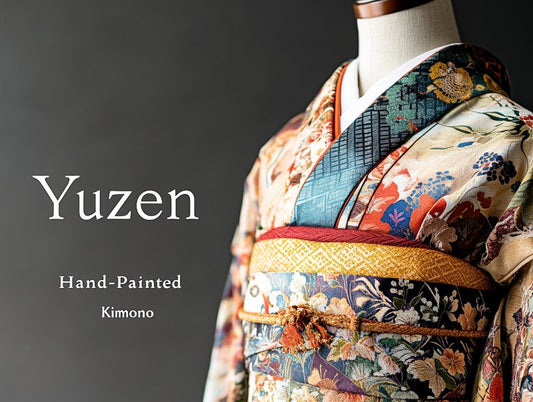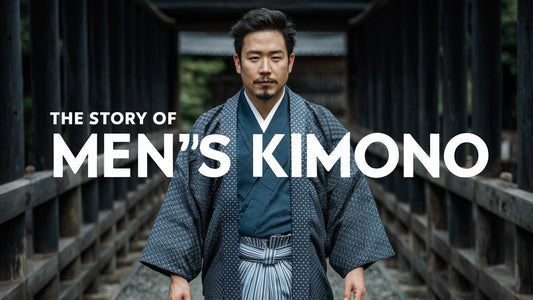Kimono: An Icon of Japanese Culture
Share
In the fascinating world of Japanese culture, the kimono holds a unique and revered position. This traditional garment, with its rich history and symbolism, has been an integral part of Japan's heritage for centuries.
From its exquisite design to the intricate craftsmanship, the kimono reflects not only the artistic sensibilities of the Japanese people but also their deep-rooted cultural values. In this article, we will delve into the significance of the kimono, understanding its role as a cultural icon in Japan.
The Origin and Evolution of Kimono
The history of the kimono can be traced back to ancient Japan. Originally inspired by Chinese clothing, the kimono underwent various transformations over the years, adapting to the changing societal norms and fashion trends.
Initially, kimonos were simply designed, straight-cut robes made from rectangular fabric pieces. However, as Japan's culture flourished and trade routes expanded, the kimono became more ornate, with intricate patterns and luxurious fabrics.

Symbolism and Meaning
The kimono is not merely a piece of clothing; it is a canvas that tells stories of Japan's cultural heritage. Every pattern, color, and fabric used in the kimono carries profound symbolism. For instance, the cherry blossom motif represents the transient nature of life, while the crane symbolizes longevity and good fortune.
Other common motifs include the pine tree, symbolizing strength, and the bamboo plant, symbolizing flexibility. Kimonos also hold significance during various life events, such as weddings, coming-of-age ceremonies, and funerals, signifying the importance of tradition in Japanese society.

The Art of Kimono Making
Creating a traditional kimono requires exceptional craftsmanship and attention to detail. Skilled artisans spend months handcrafting these garments, using intricate techniques like dyeing, weaving, and embroidery.
The process involves a deep connection between the maker and the kimono, infusing a piece of their soul into the fabric. This personal touch adds to the kimono's allure, making it an extraordinary piece of wearable art.
The kimono-making process also involves the careful selection of materials, such as silk, which contributes to the garment's luxurious texture and appearance.

Types of Kimonos
Over the centuries, different types of kimonos have emerged, each serving a specific purpose or occasion. Some of the most common types include:
1. Furisode
Furisode is a type of kimono worn by young, unmarried women during special occasions. It is characterized by its long sleeves, which can extend up to 114 centimeters, and vibrant colors and patterns.

2. Tomesode
Tomesode is a formal kimono usually worn by married women. It features shorter sleeves and elegant, subdued patterns, often with a family crest on the back.

3. Yukata
Yukata is a casual, lightweight kimono typically worn during the summer or at festivals. It is made from cotton and features simple, fun patterns.

Kimono in Modern Japan
In contemporary Japan, the kimono has adapted to the fast-paced lifestyle while preserving its cultural significance. While less commonly worn in daily life, kimonos still hold a special place during traditional ceremonies and festivals.
Additionally, there has been a resurgence in interest in wearing kimonos among the younger generation, thanks to the efforts of designers who blend traditional elements with modern aesthetics.
Kimono rental services have also become popular, allowing tourists to experience the charm of wearing a kimono during their visit to Japan.

Kimono Around the World
The kimono's allure has transcended borders, captivating people worldwide with its elegance and beauty. It has influenced global fashion trends, with designers incorporating kimono-inspired elements into their collections.
Moreover, the kimono's timeless charm has found a place in art, literature, and even pop culture, becoming a symbol of Japanese identity and cultural heritage. Many international celebrities have been seen wearing kimonos on red carpets and in fashion magazines, further popularizing this traditional garment on a global scale.
Preserving the Legacy
Despite its enduring appeal, the kimono faces challenges in an ever-changing world. There is a collective effort to preserve this cultural treasure and pass down the art of kimono making to future generations. Organizations, museums, and enthusiasts work diligently to promote the kimono's significance, ensuring that its legacy remains intact.
Special exhibitions and workshops are held to educate both locals and tourists about the cultural importance of kimonos, fostering a deeper appreciation for this iconic garment.

Conclusion
The kimono stands as an icon of Japanese culture, weaving together history, artistry, and symbolism. From its ancient origins to its continued relevance in modern times, the kimono embodies the soul of Japan's cultural heritage. Its significance stretches far beyond a piece of clothing; it is a timeless symbol of tradition and a testament to the creativity of the human spirit.
As we continue to embrace the beauty and meaning of the kimono, we honor the legacy of this cultural treasure and keep its essence alive for generations to come.
FAQs
-
Is the kimono only worn by women? No, while kimonos are traditionally associated with women's attire, there are also variations specifically designed for men.
-
Can I wear a kimono as a non-Japanese person? Yes, kimono rental services are available in many cities across Japan, allowing tourists to experience wearing this traditional garment.
-
What occasions call for wearing a kimono? Kimonos are worn during various occasions, such as weddings, tea ceremonies, festivals, and formal events.
-
Are kimonos expensive? Authentic kimonos crafted by skilled artisans can be quite costly, but there are more affordable options available for those interested in experiencing the beauty of kimonos.
-
Can the meaning of kimono patterns change over time? Yes, the symbolism of certain patterns may evolve or adapt as societal values and cultural beliefs change over the years.


